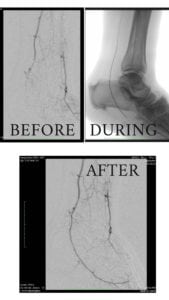Are you wondering, why are my feet numb? Or have you developed leg cramps or calf pain when you walk? While these symptoms might send you running to the podiatrist, they're actually a sign of peripheral arterial disease, a form of cardiovascular disease. Here's what you need to know, so you can get help for diagnosing PAD.

When you think about heart disease, you probably think about chest pain. Maybe you've even heard that shooting arm pain could be a heart attack warning sign. But you probably don't think about your feet telling you something about your heart. And that's a mistake.
After all, your heart's got a big job: it has to circulate blood throughout your body. But, if something slows down your circulation, this form of cardiovascular disease could trigger symptoms in your feet and legs.
For that reason, the answer to, "Why are my feet numb," could be: you've got PAD. Especially if you also notice leg cramps, skin color changes or patches of hair loss on your legs.
Why does PAD cause numbness or leg cramps? The answer is fairly simple. When you have this condition, plaque has built up inside your arteries. (We call this atherosclerosis.) This build-up narrows your arteries, so less blood gets through to your legs and feet.
What happens next? Well, with reduced blood flow, numb feet are possible. Plus, those leg cramps we mentioned can show up when you walk or exercise. And that's because your muscles are not receiving enough oxygen-rich blood to support their movement.
While April marks “Limb Loss Awareness Month” and “National Minority Health Month,” we always want to quickly answer questions like "Why are my feet numb?" by diagnosing PAD. After all, three-in-five heart attack sufferers have PAD, as do one fifth of people over 60 and one-third of people with diabetes over the age of 50. Members of minority communities have a high risk of undiagnosed PAD, which ups their risk for heart attacks, strokes, and amputations. Moreover, this study reveals the condition is underdiagnosed and undertreated.
For that reason, we support the Let’s C.H.A.T. campaign that provides clinicians with help for diagnosing PAD during routine checkups. The initials stand for Carotids, Heart, Abdomen, and Toes. And they offer a plan for determining vascular health with the tools available in a typical clinic. Here's how it all breaks down.
C: Check the neck arteries, called CAROTIDS, for an audible sound known as a bruit. This suggests problems with blood flow.
H: Check HEART rhythm and rate.
A: Listen for a bruit in the ABDOMEN.
T: Examine the TOES for foot and leg pulses. This can help detect restricted blood flow due to PAD.
Along with a comprehensive oral health history and our PAD risk assessment metric, these little letters could help patients get an earlier diagnosis. And that could reduce their risk for cardiovascular complications.
Of course, numb feet and the CHAT signals aren't the only signs of PAD. Other common symptoms include changes in your feet and legs' skin color. (Usually becoming pale, or even developing a blue-ish tinge.)
Your feet may feel cold, the growth of your leg hair and toenails may slow, or you may even develop leg ulcers. It's also important to mention that PAD symptoms differ for men and women. Some men develop erectile dysfunction with this condition. And women tend to have fewer noticeable symptoms. This means their diagnoses come later, leading to more serious complications and more invasive treatment needs.
Several lifestyle changes can help you reduce your risk for PAD. First and most important: quit smoking if you haven't already. Like PAD, smoking limits your blood flow. So the two together can make a dangerous combination.
Next, it's very important to control your cholesterol levels, maintain a healthy weight, and keep your blood sugar levels in the ideal range. Regular exercise can prevent cardiovascular disease. (And certain types of exercise can even improve PAD symptoms like leg cramps.) Of course, in some cases these measures won't be enough to prevent disease. In that case, you'll need to seek medical treatment options.

Identifying PAD is crucial, because the condition increases your risk for strokes and heart attacks, according to the Centers for Disease Control and Prevention (CDC). Because of this serious risk, preventing peripheral arterial disease is incredibly important. And so is early diagnosis and intervention.
At any of our seven Texas locations, our vascular specialists offer an easy assessment to help identify your PAD risk. If you have an elevated risk, or already have atherosclerosis, we can recommend a variety of treatment options. These include angioplasty, stenting and atherectomy. And the option we suggest for you will depend on your current health and the severity of your condition.
In some cases, numb feet and leg cramps don't mean you have PAD. In fact, if you're diabetic, the answer to "Why are my feet numb?" could be peripheral neuropathy. (This is a form of nerve damage that impacts up to 70% of diabetics. And it limits feeling in your feet, or causes tingling or burning pain.)
Neuropathy is also a common after-effect of chemotherapy. And people living with HIV may also develop this form of nerve damage. You could even develop numb feet without PAD or neuropathy: this symptom could be a side effect of certain medications, as well as autoimmune diseases, kidney problems or even liver issues.
Regardless of the cause, numb feet and leg cramps are symptoms that you can't ignore. For that reason, if you've noticed changes in foot sensation, or if you have leg cramps or other PAD warning signs, the time to act is now. When you request an appointment , we can administer the Ankle-Brachial Index (ABI, a simple bedside test) to quickly and painlessly diagnose peripheral arterial disease. Then, if that's the cause of your numb feet, we can tailor your treatment plan to prevent complications and disease progression.
Source Page: https://texaseva.com/sources/

Scheduling
Please contact our dedicated specialists to schedule a consultation today.
2025 Texas Endovascular. All rights reserved. Website Design by Healthcare Success